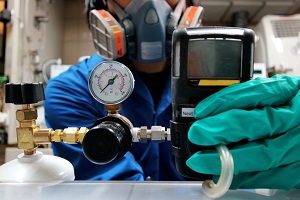Hydrogen sulfide is a gas that is produced whenever organic matter begins to decay and it’s not at all uncommon in the environment. In fact, the human body produces it as a byproduct of digestion, and it’s characterized by its foul rotten-egg odor. Though it’s colorless, its presence is almost always betrayed by its trademark odor, which can be both pungent in low doses and dangerous in concentrated quantities. Therefore, in many industries in which hydrogen sulfide is a common byproduct, detection equipment such as an H2S gas monitor can help keep the workplace safe from dangerous concentrations of the gas.

Though low levels of the gas don’t manifest in serious health issues, prolonged exposure or exposure to concentrated amounts of hydrogen sulfide can begin a cascade of health hazards that can be quite severe. Installing an H2S gas detector can help protect those who must work in environments where H2S is present, as the consequences of unchecked exposure to H2S can be lethal. Keep reading to learn more about hydrogen sulfide and the hazards it can pose to human health.
Dangers of H2S
One of the problems associated with H2S is that it is usually only detected thanks to its strong smell. However, human olfactory senses will become scent blind after exposure to a pungent smell. In other words, when the nose is inundated with a powerful odor, the olfactory sense adjusts so that the smell becomes barely noticeable after only a short period. That can pose a significant threat to those who work in industries where hydrogen sulfide is routinely present because without guidance from the nose, people may never know they’re being exposed to dangerous levels of H2S. The Occupational Health and Safety Administration sets the maximum exposure limit for hydrogen sulfide, and that limit currently stands at 10 parts per million in any 8-hour period.
Minimal Exposure
Minimal exposure to H2S is categorized as being in the presence of concentrations of 10 parts per million or less. Even at those low concentrations, there can be noticeable degradation in comfort for human beings, as eyes may begin to water. Also, those who have been exposed to low doses of hydrogen sulfide may experience sharp coughing and shortness of breath in the short term. If exposure persists for longer periods, additional symptoms of exposure could occur such as headaches, fatigue, inflammation of eyes and mucous membranes, irritability, weight loss, and difficulty sleeping.
Moderate Exposure

Moderate exposure is characterized as exposure to concentrations in excess of 10 parts per million up to 99 parts per million. As the concentrations increase, so do the health ramifications of exposure. When moderate exposure occurs, humans experience severe eye irritation and swelling, intense fits of coughing and breathing difficulty, and profound headache. Also, those who are exposed may have trouble maintaining balance, leading them to stagger, become nauseated, and begin prolific vomiting.
High Exposure
High levels of exposure to H2S can have serious, life-threatening consequences for most people. High exposure includes any concentration above 100 parts per million, though the risk and associated consequences increase exponentially as the concentrations escalate. The body can go into shock quickly after exposure, putting major organs at risk of failure. Breathing may cease, and convulsions are another common symptom of extreme H2S exposure. Unconsciousness, coma, and death can also strike soon after exposure to high concentrations of hydrogen sulfide. In fact, about half of people who are exposed to a concentration of 800 parts per million for 5 minutes won’t survive, and one breath of air tainted with 1000 parts per million of H2S would cause immediate death.
Because hydrogen sulfide is a common byproduct of many industries and the consequences of unchecked exposure are so grave, it’s important that fixed and portable H2S gas detectors are utilized to protect the safety of employees and the general public. To learn more about the health risks associated with hydrogen sulfide exposure, contact DOD Technologies Inc. at (815) 680-6086.






